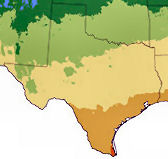All of the Houston area falls into zones 8b (15-20 degrees) or 9a (20-25 degrees), with zone 9b (25–30 degrees) along the coast.
Global warming is hitting not just home but garden for much of the country. The color-coded map of planting zones often seen on the back of seed packets is being updated by the government, illustrating a hotter 21st century.
It is the first time since 1990 that the U.S. department of Agriculture has revised the official guide for the nation’s 80 million gardeners, and much has changed. The hardiness map, which indicates minimum low temperatures in specific areas, is a tool for deciding what to plant.
The new guide was – unveiled Wednesday at the National Arboretum in Washington, D.C., and reflects a new reality; The coldest day of the year isn’t as cold as it used to be, so some plants and trees now can survive farther north.
In the Houston area, most of Harris County is now in zone 9a, with average minimum winter temperatures of 20 to 25 degrees. Under the previous map, only the southern half of the county was in that zone. The northern area was in 8b, with average minimums of 15 to 20 degrees. Montgomery County now straddles zones 8b and 9a.
The new categories mean gardeners in north Harris County and south Montgomery County may successfully try plants not previously recommended because of their sensitivity to cold. The new map is no surprise to Houston nurseryman Mike Lowery, who considers ours a semitropical growing zone. He expects no change in Houston gardeners’ habits. “The new map confirms what we already knew,” says the owner of Another Place in Time. “To me, the previous two winters with hard freezes were a blip. I consider this mild winter the norm.”
Cornelius Nurseries’ Eddie Russell looks at the map as a guideline, especially in trying new plant cultivars. But overall he also expects the map to have minimal effect in this region.
It’s a different story in other states.
The map carves the U.S. into 26 zones based on five-degree temperature increments. The 1990 map mentions 34 U.S. cities in its key. On the 2012 map,18 of those, including Honolulu; St. Louis; Des Moines, Iowa; St. Paul, Minn.; and even Fairbanks, Alaska, are in newer, warmer zones. For example Des Moines used to be in zone 5a, meaning the lowest average temperature was between minus 15 and minus 20. Now it’s 5b which has a lowest temperature of 10 to 15 degrees below zero. Jerry Holub, manager of a Des Moines plant nursery, said folks there might now be able to safely grow passion flowers.
“It is great that the federal government is catching up with what the plants themselves have known for years now: The globe is warming and it is greatly influencing plants (and animals),” Stanford University biology professor Terry Root said.
The changes come too late to make this year’s seed packets, but they will be in next year’s, said George Ball, chairman and CEO of the seed company W. Atlee Burpee, which puts the maps on packages of perennials, not annuals. But Ball said many of his customers already know what can grow in their own climate and how it has warmed.
The new guide uses better weather data and offers more interactive technology. For example, gardeners using the online version of the USDA Plant Hardiness Zone Map can enter their ZIP code and get the exact average coldest temperature. The website also offers a detailed map of East Texas. USDA spokeswoman Kim Kaplan, who was part of the map team, repeatedly tried to distance the new zones on the map from global warming. She said that while much the country is in warmer zones, the map “is simply not a good instrument” to demonstrate climate change, because it is based on just the coldest days of the year.
But David W. WoIfe, a professor of plant and soil ecology at Cornell University, said that the USDA is being too cautious and that the map plainly reflects warming.
The Arbor Day Foundation issued its own hardiness guide six years ago, and the new map is very similar, said Woodrow Nelson, a vice president at the plant-loving organization. “We got a lot of comments that the 1990 map wasn’t accurate anymore,” Nelson said. “I look forward to (the new map). It’s been a long time coming.” Nelson lives in Lincoln, Neb., where the zone warmed to a 5b. He used to be in a “solid 4,” but now he has Japanese maples and Fraser firs in his yard – trees that shouldn’t survive in a zone 4.
Source: Houston Chronicle, USDA

Leave a Reply